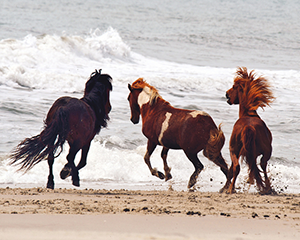The Wild Ponies
Viewing the Assateague Horses Safely
 During your visit to Assateague, you will most likely encounter at least a few of the island's most popular residents. Petting or feeding the wild horses may seem like a harmless and fun thing to do, but the consequences can be terrible. For your safety and the safety of the horses, please obey park regulations and do not approach, touch, or feed the Assateague horses.
During your visit to Assateague, you will most likely encounter at least a few of the island's most popular residents. Petting or feeding the wild horses may seem like a harmless and fun thing to do, but the consequences can be terrible. For your safety and the safety of the horses, please obey park regulations and do not approach, touch, or feed the Assateague horses.
Assateague horses do bite, kick and can carry rabies. These horses are WILD, and they don't behave like domestic horses. Treat the horses with respect - move back and stay safe.
Stay at least a "bus length" or 40 feet away, but remember that may still be too close depending on the circumstances. If horses approach you, back off and retreat to a safe distance. Do not take food to the beach unless in a cooler that is zippered or secured with a nylon strap. Even then, if horses approach your food, you must move away.
Frequently Asked Questions
Where can I go to see the horses?
The horses are feral and roam freely throughout the Maryland section of the island, so they can be anywhere at any time. The horses can often be found in the marsh areas, on the beach, or further down the island in the National Park’s OSV (Over Sand Vehicle) area. When visiting the island to see the horses, be sure to follow all regulations including not stopping or parking along roadways or getting closer than 40 feet to any wildlife. The best option is to park at the State Park or National Park day-use area and enjoy a walk along the trails or beach in search of the horses in their natural habitat. There is no guarantee that by paying the service charge visitors will see horses.
Can I touch or feed the horses?
It is illegal to touch or feed any wildlife. Citations are issued when visitors are observed doing so. It is dangerous both for the horses and for people when interactions are too close. Animals can easily pick up scavenging practices, so never feed them. Animals stay healthier when you do not feed them. And, once they learn to beg, they can become aggressive, more likely to get injured by vehicles, and can become seriously ill. Although they appear harmless and even curious about you, horses injure visitors every year. That’s partly why approaching, harassing, or feeding any kind of wildlife, no matter how small or familiar, is illegal.
The wild horses on Assateague Island are managed by the National Park Service.
Visit this link to learn more about how your behaviors can contribute to a safer habitat for horses and a more enjoyable visit for people.
How many horses are on the island?
There are two herds; one in Maryland and one in Virginia. There are approximately 78 in the Maryland herd and about 150 in the Virginia herd. A contraceptive darting program may be used with the Maryland horses in order to keep the population size to a sustainable number.
Other Information
Local lore experts theorized the ponies arrived on the island via a shipwrecked vessel in the late 18th or early 19th century. Others attribute their arrival by pirates drawn to the island who ultimately abandoned the animals. A more likely theory is that farmers in colonial times used the island for grazing areas to avoid paying taxes on the land.
The National Park Service manages the herd of ponies at the northern end of Assateague Island. The separate herd in Virginia is owned by the Chincoteague Volunteer Fire Department, which sponsors the annual pony penning and swim every July.
The ponies’ diet consists mainly of marsh and dune grasses. Their water comes from the freshwater ponds located on the island. They are true horses, and not actual ponies, who have adapted to the diet and life on Assateague.
During the winter their coats become quite thick to protect them from the harsh winds. Their short, stocky build allows them to navigate the marshes and to store water efficiently.
Did you know that the horses’ eyes do not reflect light at night? This makes them difficult to see after dark so drive safely and stay alert!